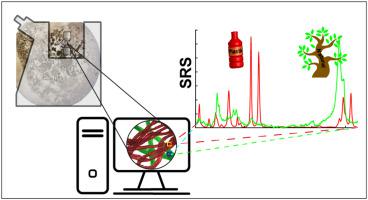Environmental Pollution ( IF 7.6 ) Pub Date : 2020-09-16 , DOI: 10.1016/j.envpol.2020.115640 Sergey P. Laptenok , Cecilia Martin , Luca Genchi , Carlos M. Duarte , Carlo Liberale

|
Microfibers are reported as the most abundant microparticle type in the environment. Their small size and light weight allow easy and fast distribution, but also make it challenging to determine their chemical composition. Vibrational microspectroscopy methods as infrared and spontaneous Raman microscopy have been widely used for the identification of environmental microparticles. However, only few studies report on the identification of microfibers, mainly due to difficulties caused by their small diameter. Here we present the use of Stimulated Raman Scattering (SRS) microscopy for fast and reliable classification of microfibers from environmental samples. SRS microscopy features high sensitivity and has the potential to be faster than other vibrational microspectroscopy methods. As a proof of principle, we analyzed fibers extracted from the fish gastrointestinal (GIT) tract, deep-sea and coastal sediments, surface seawater and drinking water. Challenges were faced while measuring fibers from the fish GIT, due to the acidic degradation they undergo. However, the main vibrational peaks were still recognizable and sufficient to determine the natural or synthetic origin of the fibers. Notably, our results are in accordance to other recent studies showing that the majority of the analyzed environmental fibers has a natural origin. Our findings suggest that advanced spectroscopic methods must be used for estimation of the plastic fibers concentration in the environment.
中文翻译:

刺激拉曼光谱法作为对环境样品中的微纤维进行分类的新方法
据报道,微纤维是环境中最丰富的微粒类型。它们的体积小,重量轻,可以轻松快速地进行分配,但也很难确定其化学成分。振动显微光谱法,如红外光谱和自发拉曼光谱法,已被广泛用于鉴定环境微粒。然而,只有很少的研究报道了对微纤维的鉴定,这主要是由于其直径小造成的困难。在这里,我们介绍使用受激拉曼散射(SRS)显微镜对环境样品中的超细纤维进行快速可靠的分类。SRS显微镜具有很高的灵敏度,并且具有比其他振动显微光谱法更快的潜力。作为原理证明,我们分析了从鱼胃肠道,深海和沿海沉积物,地表海水和饮用水中提取的纤维。由于鱼会经历酸性降解,因此在测量鱼GIT中的纤维时面临挑战。但是,仍然可以识别出主要的振动峰,并且足以确定纤维的天然或合成来源。值得注意的是,我们的结果与其他最近的研究结果一致,这些研究表明,大多数被分析的环境纤维都具有天然来源。我们的发现表明,必须使用先进的光谱方法来估算环境中塑料纤维的浓度。由于它们经历了酸性降解。但是,仍然可以识别出主要的振动峰,并且足以确定纤维的天然或合成来源。值得注意的是,我们的结果与其他最近的研究结果一致,这些研究表明,大多数被分析的环境纤维都具有天然来源。我们的发现表明,必须使用先进的光谱方法估算环境中塑料纤维的浓度。由于它们经历了酸性降解。但是,仍然可以识别出主要的振动峰,并且足以确定纤维的天然或合成来源。值得注意的是,我们的结果与其他最近的研究结果一致,这些研究表明,大多数被分析的环境纤维都具有天然来源。我们的发现表明,必须使用先进的光谱方法估算环境中塑料纤维的浓度。











































 京公网安备 11010802027423号
京公网安备 11010802027423号